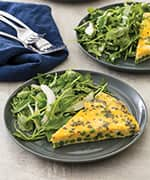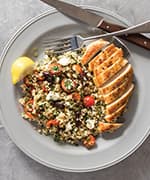LIFE EXTENSION MAGAZINE
Gut health is vital to your overall health and longevity. Beyond influencing your digestive system, it plays a role in immunity, emotions, and in how well you absorb nutrients from food.
The cookbook, Cook for Your Gut Health, from America’s Test Kitchen, provides recipes designed to encourage a healthy microbiome.
These recipes are packed with fiber to help keep you regular, provide prebiotics that help feed the good bacteria in your gut, and help prevent chronic inflammation in your GI tract.
All the recipes can be adjusted to be gluten-free, lactose-free, or wheat-free. And 60 of the recipes in Cook for Your Gut Health are naturally low FODMAP, while others can be easily customized to be low FODMAP.
FODMAPs are fermentable carbohydrates that are notorious for triggering digestive symptoms like pain, gas, and bloating. A low-FODMAP diet is recommended for anyone suffering from irritable bowel syndrome (IBS) and other digestive disorders.
In addition to its gut-friendly recipes, Cook for Your Gut Health provides an in-depth education on the science of gut health, how to eat to support a healthy gut, and information on the low-FODMAP diet.
The following recipes from the book prove that you don’t have to sacrifice flavor or variety to support a healthy gut.
—Laurie Mathena
Pea and Feta Frittata
Serves 4
- 12 large eggs
- 1/3 cup whole milk
- ½ teaspoon plus pinch table salt, divided
- 2 ounces feta cheese, crumbled into ½-inch pieces (½ cup)
- 2 tablespoons minced fresh oregano
- 2 tablespoons extra-virgin olive oil, divided
- 2 cups frozen peas
- Pinch red pepper flakes (optional)
- ½ teaspoon grated lemon zest plus 2½ teaspoons juice, divided
- 6 ounces (6 cups) baby arugula
- 1 fennel bulb, stalks discarded, bulb halved, cored, and sliced thin
- Adjust oven rack to middle position and heat oven to 350 degrees. Whisk eggs, milk, and ½ teaspoon salt in bowl until well combined. Stir in feta and oregano.
- Heat 1 teaspoon oil in 12-inch ovensafe nonstick skillet over medium-high heat until shimmering. Add peas, pepper flakes, and 1/4 cup water. Cover and cook until peas are bright green and just tender, 3 to 5 minutes. Uncover, stir in lemon zest and ½ teaspoon juice and cook until skillet is dry, about 1 minute.
- Add egg mixture and cook, using rubber spatula to stir and scrape bottom of skillet until large curds form and spatula leaves trail through eggs but eggs are still very wet, about 30 seconds. Smooth curds into even layer and cook, without stirring, for 30 seconds. Transfer skillet to oven and bake until frittata is slightly puffy and surface bounces back when lightly pressed, 6 to 9 minutes.
- Using rubber spatula, loosen frittata from skillet and transfer to cutting board. Let sit for 5 minutes. Meanwhile, whisk remaining 5 teaspoons oil, remaining 2 teaspoons lemon juice, and remaining pinch salt together in large bowl.
Add arugula and fennel and toss to coat. Season with salt and pepper to taste. Serve.
Make it Low FODMAP Substitute dairy-free or lactose-free milk for whole milk. Substitute 2 cups frozen broccoli florets, thawed and chopped, for peas. Increase arugula to 8 ounces and reduce fennel to ½ bulb.
Make it Dairy Free Substitute dairy-free milk for the whole milk. Omit feta.
Salmon, Avocado, Orange, and Watercress Salad
Serves 4
- 2 (6- to 8-ounce) skin-on salmon fillets, 1 inch thick
- 3 tablespoons plus 1 teaspoon extra-virgin olive oil, divided
- ¾ teaspoon table salt, divided
- ⅛ teaspoon pepper
- 3 oranges
- 1 teaspoon white wine vinegar
- 1 teaspoon Dijon mustard
- 4 ounces (4 cups) watercress, torn into bite-size pieces
- 1 avocado, halved, pitted, and sliced thin
- ¼ cup fresh mint leaves, torn
- ¼ cup hazelnuts, toasted and chopped
- Adjust oven rack to lowest position, place aluminum foil-lined rimmed baking sheet on rack, and heat oven to 500 degrees. Make 4 or 5 shallow slashes, about 1 inch apart, on skin side of each fillet, being careful not to cut into flesh. Pat salmon dry with paper towels, rub with 1 teaspoon oil, and sprinkle with 1/4 teaspoon salt and pepper.
- Reduce oven temperature to 275 degrees and remove sheet from oven. Carefully place salmon skin side down on hot sheet. Roast until center is still translucent when checked with tip of paring knife and registers 125 degrees (for medium-rare), 8 to 12 minutes. Transfer salmon to plate. Let cool completely, about 20 minutes. Using 2 forks, flake salmon into rough 2-inch pieces; discard skin.
- Meanwhile, cut away peel and pith from oranges. Holding fruit over bowl, use paring knife to slice between membranes to release segments. Measure out 2 tablespoons orange juice and transfer to separate bowl.
- Add vinegar, mustard, remaining 3 tablespoons oil, and remaining ½ teaspoon salt to bowl with orange juice and whisk until smooth. Arrange watercress in even layer on serving platter. Top with salmon pieces, orange segments, and avocado. Drizzle vinaigrette over top, then sprinkle with mint and hazelnuts. Serve.
Make it Low FODMAP Reduce avocado to ½ avocado (4 ounces).
Pan-Seared Chicken Breasts with Artichoke, Tomato, and Bulgur Pilaf
Serves 4
- ½ teaspoon ground cumin
- ¼ teaspoon plus ⅛ teaspoon table salt, divided
- ⅛ teaspoon pepper
- 4 (6-ounce) boneless, skinless chicken breasts, trimmed
- ¼ cup extra-virgin olive oil, divided
- 1½ cups jarred whole baby artichokes packed in water, rinsed, patted dry, and quartered
- 2¼ cups water
- 1½ cups medium-grind bulgur
- 10 ounces cherry tomatoes, halved
- 3 ounces feta cheese, crumbled (¾ cup)
- ¾ cup minced fresh parsley
- 1/3 cup pitted kalamata olives, chopped
- 1 tablespoon lemon juice
- Combine cumin, 1/4 teaspoon salt, and pepper in bowl. Cover chicken breasts with plastic wrap and pound to uniform thickness as needed. Pat dry with paper towels and sprinkle with cumin mixture.
- Heat 1 tablespoon oil in 12-inch skillet over medium-high heat until just smoking. Cook breasts, turning as needed, until golden brown and register 160 degrees, about 10 minutes. Transfer breasts to plate, tent with aluminum foil, and let rest while preparing pilaf.
- Heat 1 tablespoon oil in now-empty skillet over medium-high heat until shimmering. Add artichoke hearts and cook, without stirring, until spotty brown, about 2 minutes. Stir in water, scraping up any browned bits, and bring to boil. Stir in bulgur and remaining 1/8 teaspoon salt. Off heat, cover and let sit until grains are softened and liquid is fully absorbed, about 5 minutes.
- Add tomatoes, feta, parsley, olives, lemon juice, and remaining 2 tablespoons oil to pilaf and gently fluff with fork to combine. Season with pepper to taste. Serve chicken with pilaf.
Make It Dairy Free Omit feta.
If you have any questions on the scientific content of this article, please call a Life Extension Wellness Specialist at 1-866-864-3027.
To order a copy of Cook for Your Gut Health, call 1-800-544-4440 or visit www.LifeExtension.com
Item #34192 • Price: $22.49





